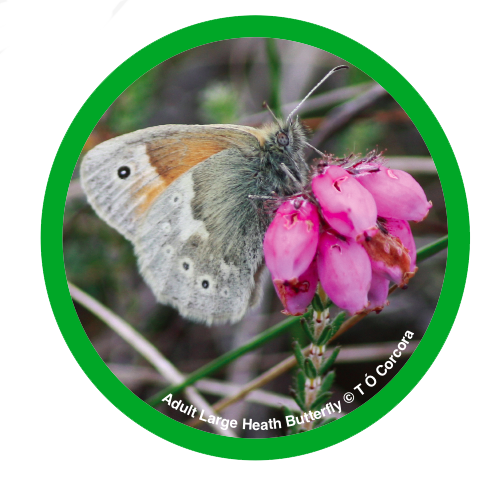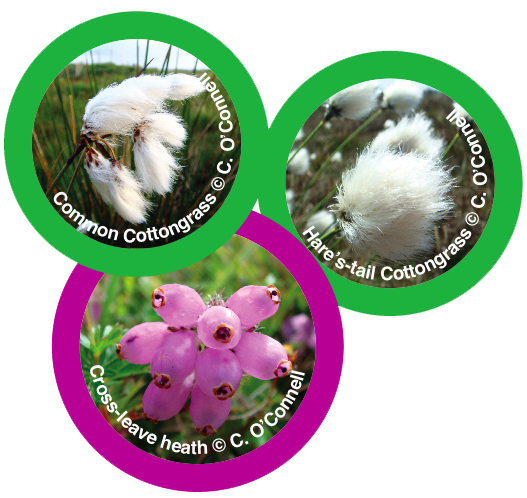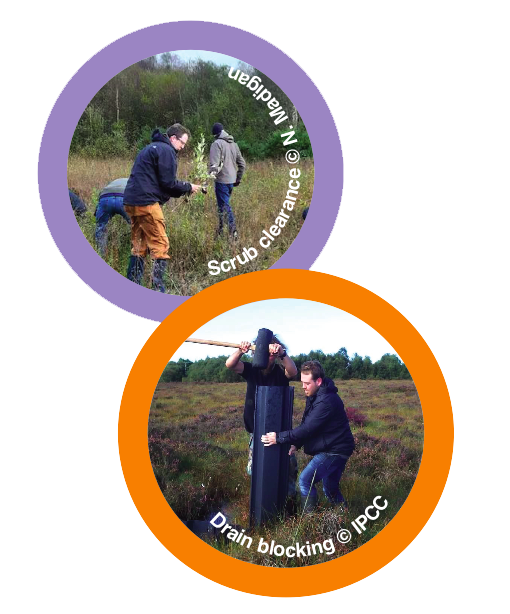 The Large Heath (Coenonympha tullia) is a medium sized butterfly with a wingspan of 35-40mm. Both the male and female are quite similar. The upper wings are tawny with dark spots. The underwings are grey to rusty-brown with an irregular white streak and ringed eyespots on the underside of the hindwing. The number of spots vary from 1-6. One characteristic of this uncommon butterfly is its erratic flight pattern across the vegetation. Little is known about this butterfly as it is under-recorded and rarely studied in Ireland.
The Large Heath (Coenonympha tullia) is a medium sized butterfly with a wingspan of 35-40mm. Both the male and female are quite similar. The upper wings are tawny with dark spots. The underwings are grey to rusty-brown with an irregular white streak and ringed eyespots on the underside of the hindwing. The number of spots vary from 1-6. One characteristic of this uncommon butterfly is its erratic flight pattern across the vegetation. Little is known about this butterfly as it is under-recorded and rarely studied in Ireland.
Foodplant
The larva and adult of the Large Heath Butterfly feed on different food sources. Hare’s-tail Cottongrass is the main foodplant of the larvae. It is found on open acidic peatlands and cutover peatlands. It is a member of the sedge family with long slender leaves. From April to May it produces a single flower spike and from May it has a cotton-like fruiting body on a single stalk. The larvae have also been known to feed on Common Cottongrass. The adult flies low, feeding on nectar provided by Cross-leaved Heath.
Cottongrass is the main foodplant of the larvae. It is found on open acidic peatlands and cutover peatlands. It is a member of the sedge family with long slender leaves. From April to May it produces a single flower spike and from May it has a cotton-like fruiting body on a single stalk. The larvae have also been known to feed on Common Cottongrass. The adult flies low, feeding on nectar provided by Cross-leaved Heath.
Habitat Management
Grazing: Light sheep grazing may be required on drier sites to prevent heather becoming dominant. Grazing is not needed on sites where productivity is low or on very wet sites. Careful management of stocking levels is required as overgrazing can cause a deterioration in the quality of the habitat.
 Scrub Clearance: Removal of scrub and tree saplings is necessary on raised and
Scrub Clearance: Removal of scrub and tree saplings is necessary on raised and
blanket peatland sites where drainage has occurred causing the peatland to dry. Tall heather grows on very dry sites and heather cutting may be required. Burning and the use of heavy machinery is not recommended.
Hydrology: Where peatlands have been drained, blocking these drains is essential to raise the water table to within 10cm of the surface. There are a number of different approaches to this method of restoring the hydrology of the site including using plastic lumbar or peat.
Threats
Climate change and human activities including afforestation, peat extraction and drainage, threaten the survival of this species. According to Ireland’s Red List No. 4 Butterflies, a 30% decrease in the future population of the Large Heath butterfly is predicted, due to deteriorating quality of habitat. As a result, the Large Heath butterfly is listed as Vulnerable (VU) on the European and Irish Red List for Butterflies. Drainage of peatlands for peat extraction causes the site to become drier, altering the hydrology and making conditions suitable for the encroachment of invasive species and scrub.
Learn More about the Large Heath Butterfly including its life cycle by downloading IPCC’s Large Heath Butterfly Leaflet
Recording Large Heath Butterflies
To gather data on the distribution and populations of Large Heath Butterflies in Ireland the National Biodiversity Data Centre have developed a Large Heath Habitat Condition and Recorder Observation Survey. If you have identified Large Heath Butterflies on one of your local peatland habitats become a citizen scientist and submit your observations to the National Biodiversity Data Centre.
Large Heath Butterfly Habitat Condition Form
Large Heath Butterfly Recorder Observation Form
To learn more join the Irish Peatland Conservation Council in June during the annual Large Heath Butterfly monitoring on Lodge Bog Co. Kildare, contact us on bogs@ipcc.ie or +353-45-860133 for further information.
© Irish Peatland Conservation Council (unless otherwise stated), Bog of Allen Nature Centre, Lullymore, Rathangan, Co. Kildare. Email: bogs@ipcc.ie; Tel: +353-45-860133.
